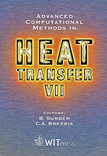Aspects Regarding The Heat Transfer In Furnaces For Rolling Mills
Price
Free (open access)
Transaction
Volume
35
Pages
10
Published
2002
Size
424 kb
Paper DOI
10.2495/HT020271
Copyright
WIT Press
Author(s)
D Constantinescu & I Tone
Abstract
From the very beginning we have to state an important difference which exists between various types of continuous operating furnaces: while in the pusher-type furnace the billets can be disposed only one near tie other, without free spaces between them, the walking-beam furnace or the rotary hearth furnace allow the disposal of the billets at the required distances. Modifying this distance there is the possibility of acting upon the stationary time [l] of the billets in the furnace, upon temperature distribution in the billets section. Considering, for the beginning, that the thermal flow is received only by the billet upper face - it is important to establish the necessary time for transmitting the heat through conductivity to the billet lower surface. It is therefore appearing a ‘‘difference time” until reaching the same temperature value on both sides. The curve representing the cold surface temperature variation in relation with billet position in the furnace, can be obtained from tie curve representing the cold surface temperature variation at a distance which corresponds to the metallic material quantity passing through the furnace in a time unit, multiplied with billet thickness [2], [3], (figure 1). Four real heating situations in a walking-beam furnace are presented in figure 1. Heating zone length suitable to the interval BA is noted with ”lc”, corresponding to the time to increase the billet center temperature to the surface temperature. l , = B C = n . e = K . e . P (1) e: thickness of square section of the billet P: furnace productivity K: factor established on the heating duration and material’s parameters
Keywords





